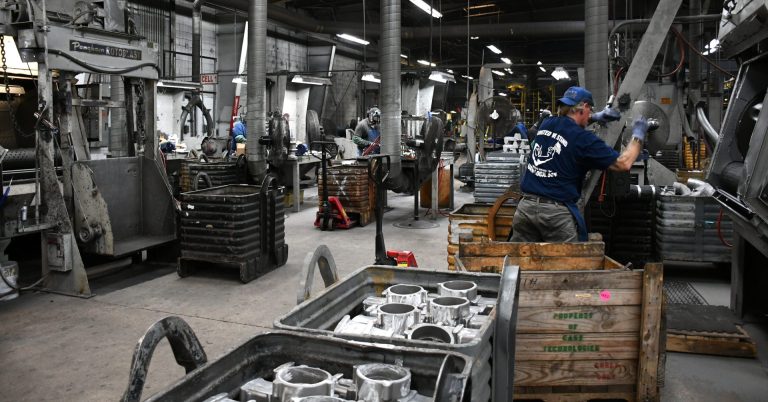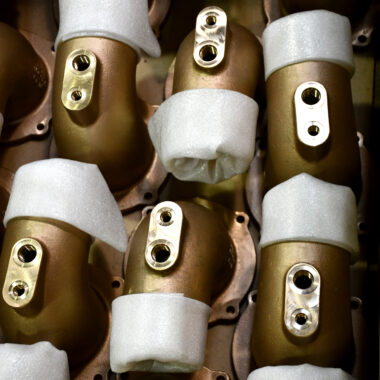The Insider's Guide to Effective Casting Aluminum Illinois
The Insider's Guide to Effective Casting Aluminum Illinois
Blog Article
Achieving Quality in Light Weight Aluminum Casting: Vital Advice
In the world of light weight aluminum high quality, spreading and precision are critical. From carefully picking the appropriate materials to developing putting methods and guaranteeing meticulous ending up touches, accomplishing excellence in light weight aluminum casting requires a blend of knowledge and attention to information.

Products Option
Picking the appropriate materials is critical in making sure the success and top quality of your light weight aluminum casting tasks. The selection of products significantly impacts the final residential properties of the casted items, consisting of stamina, toughness, and total top quality. When picking materials for light weight aluminum spreading, it is crucial to consider factors such as the sort of light weight aluminum alloy, the wanted mechanical properties, and the spreading technique being utilized.
Aluminum alloys are typically made use of in casting due to their lightweight nature and superb mechanical properties. The selection of the details alloy relies on the application demands, with choices ranging from high-strength alloys ideal for architectural elements to corrosion-resistant alloys for marine settings. Recognizing the features of various aluminum alloys is essential for picking the most appropriate one for your task.
Additionally, the casting approach employed, whether it be sand spreading, die spreading, or investment casting, likewise influences product selection. Each spreading method has its very own requirements in regards to material fluidness, thermal conductivity, and mold compatibility. By meticulously thinking about these factors, you can make sure that the materials picked are tailored to satisfy the specific requirements of your aluminum casting job.
Mold And Mildew Preparation
In the world of aluminum spreading, the meticulous preparation of mold and mildews stands as a vital forerunner to the actual spreading procedure. Mold preparation entails several necessary steps to make certain the quality and accuracy of the last actors product. It is critical to clean the mold thoroughly to get rid of any type of dust, deposit, or previous spreading residues that can jeopardize the new actors. This cleaning procedure assists maintain the integrity of the mold and prevents flaws in the final item.
Next, applying a suitable mold finishing is vital to help with the launch of the actors light weight aluminum and enhance the surface finish of the part. The kind of layer made use of will certainly depend upon variables such as the complexity of the mold and mildew, the preferred surface area finish, and the spreading product. Additionally, proper airing vent and gating systems need to be integrated into the mold layout to permit the smooth flow of molten light weight aluminum and protect against the formation of air pockets or defects in the cast component.
Melting and Pouring Strategies
To achieve effective light weight aluminum spreading, grasping reliable melting and pouring methods is vital for guaranteeing high-grade and exact results. The melting procedure is an essential action in light weight aluminum spreading, where the metal is heated up to its fluid state.
Once the light weight aluminum reaches the desired molten state, correct pouring methods have to be utilized to move the steel into the molds. The speed and uniformity of the put are essential variables in achieving consistent filling of the mold and mildew cavity and decreasing the threat of issues like air entrapment or incomplete spreading. Gravity putting, low-pressure spreading, or centrifugal casting methods can be used based upon the details requirements of the project.
Cooling and Solidification Control
Accomplishing precise control over the cooling and solidification process is important in light weight aluminum spreading to preserve the stability and quality of the final casted products. Correct cooling and solidification control assistance avoid flaws such as porosity, warm rips, and contraction that can endanger the mechanical homes of the casted light read more weight aluminum elements.
One necessary element of cooling and solidification control is the design and positioning of cools. Cools are metal items tactically put in the mold and mildew to absorb heat rapidly from specific locations of the spreading, promoting uniform solidification and decreasing the possibility of problems. Additionally, regulating the air conditioning price by changing the mold's product, design, and the application of insulating finishings can influence the microstructure and mechanical residential or commercial properties of the final casting.
Additionally, monitoring and regulating the air conditioning process through making use of thermocouples and computer system simulations enable for real-time modifications to optimize air conditioning rates and solidification patterns. By implementing these strategies, factories can enhance the top quality and uniformity of their light weight aluminum castings, fulfilling the rigid requirements of various markets.
Finishing and High Quality Assessment
Correctly executed completing and quality examination processes are essential in making certain the total honesty and dependability of light weight aluminum castings, building on the thorough air conditioning and solidification control methods used during the spreading process. Completing techniques such as grinding, sanding, and brightening help eliminate excess product, smooth rough surfaces, and boost the castings' final look. These procedures not only enhance the visual appeal however also make sure dimensional precision and performance.

Verdict
Finally, achieving excellence in light weight aluminum casting calls for careful factor to consider of products choice, thorough mold prep work, precise melting and pouring strategies, effective cooling and solidification control, along with top article comprehensive ending up and quality assessment procedures. By following these necessary tips and techniques, makers can make sure the manufacturing of high-quality aluminum spreadings that fulfill industry standards and client assumptions.
When picking materials for aluminum casting, it is important to take into consideration factors such as the type of aluminum alloy, the preferred mechanical buildings, and the casting method being used.
Furthermore, the casting technique utilized, whether it be sand spreading, pass away spreading, or financial investment spreading, additionally affects product option.In the world of light weight aluminum spreading, the thorough prep work of mold and mildews stands as an essential forerunner to the real spreading procedure. Gravity putting, low-pressure casting, or centrifugal casting techniques can be utilized based on the specific demands of the task.

Report this page